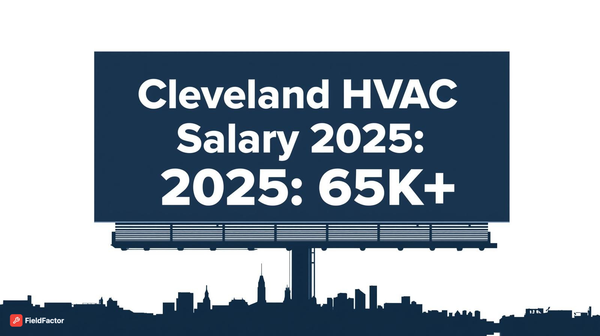Close at 70%: Master the High-Integrity HVAC Sales Process
Elevate your HVAC close rate. Learn the ethical, low-pressure sales system to win high-value jobs by leading with transparency and becoming a trusted advisor.

Real advice from working pros on building trust, offering options, and closing jobs without feeling like a car salesman.
You know the feeling: You roll up to a service call, diagnose the issue, and realize the $12,000 system replacement is the right recommendation for the customer. But the moment those words leave your mouth, you feel like you’ve turned into a caricature of a pushy salesman. You hate the vibe, and your customer can sense it.
This common frustration is exactly what a young technician recently confessed on r/ProHVACR. He asked the community for help: How do I close more jobs without being a “POS” salesman?
The thread exploded. Over thirty frontline technicians, service managers, and small contracting business owners jumped in with raw, field-tested advice. What emerged is a definitive playbook for every tech who wants to increase their average ticket and close rate, not through high-pressure tactics, but through deep, unshakeable customer trust.
Here are the eight most powerful lessons from the trenches on how to be the most trusted—and most successful—tech in your market.
1. Service First, Sales Second: The Mindset Shift
The single most repeated piece of advice wasn't about a clever closing line; it was a fundamental shift in perspective.
Stop thinking of yourself as a salesman. You are a highly-paid, problem-solving consultant who happens to work on HVAC systems.
When you show up, your primary goal is to educate, not to advocate for the sale. A successful tech isn’t selling a new system; they are presenting a solution to a problem they have meticulously diagnosed and explained.
Actionable Takeaway:
When presenting a recommendation, use language like:
- “Based on what I see here—the age of the unit, the rust on the heat exchanger, and your monthly energy costs—I have three ways we can solve this for you.”
- “My job is to give you all the information so you can make the best financial and comfort decision for your home.”
Customers don't trust an advocate (a salesman). They trust an educator (a technician).
2. Play the Long Game: Word of Mouth > Flashy Sales Tricks
The temptation to close every single large-ticket job on the first visit is strong. But techs who prioritize a single big sale over a long-term customer relationship are sacrificing their reputation for short-term gain.
Happy customers are your best—and cheapest—advertising.
A quick, pushy close might work once, but that customer will never call you back. Worse, they’ll tell their neighbor, family, and online review community about their negative experience. A tech who demonstrates honesty, even if it means a smaller sale today, is building a reputation that compounds over time.
Actionable Takeaway:
- Fix what needs fixing first. If the repair is $800 and the replacement is $10,000, but you know the repair will buy them two years of comfort, present that honestly.
- Mention the replacement, but frame the repair as the ethical, immediate fix. They will remember your honesty when the unit finally dies and they call you for the $10,000 job.
3. The Power of Control: Always Give Options (Good, Better, Best)
Nothing makes a customer feel more cornered than being presented with a single, high-cost solution. It triggers an automatic defense mechanism: I need to get a second opinion.
The "Good, Better, Best" model is foundational to non-pushy selling because it hands the power of choice back to the customer.
- Good (The Essential Repair/Standard): The lowest cost, compliant solution to get them operational (e.g., repairing the leaking coil, installing a 14 SEER unit).
- Better (The Value Option): A mid-tier solution that offers a significant upgrade in efficiency, comfort, or warranty for a reasonable bump in price (e.g., an entry-level variable speed unit).
- Best (The Premium Solution): The top-of-the-line system that delivers maximum comfort, energy savings, and warranty protection (e.g., a top-tier inverter system).
When a customer picks an option, they’re not being sold; they’re making a decision. You’ve changed your role from salesman to menu-designer.
4. Talk Money Without the Awkwardness
Many techs avoid the money conversation until the very end, which is a major source of friction and "sticker shock."
You must flush out financing needs early.
Seasoned pros on the thread recommended a simple technique: introduce the payment structure right after you’ve completed your diagnosis and before you present the options.
Example Script:
- “Before I walk you through the three options to solve this, I want to quickly cover payment. Our process is a 10% down payment today to get the job scheduled and the equipment ordered, and the balance is due on completion. We accept cash, card, or we have several 3rd-party financing options available through [Financing Partner].”
This simple, confident statement achieves three things:
- It normalizes the cost and payment structure.
- It lets the customer know they’ll need to make a financial decision today.
- It opens the door for them to say, “Tell me more about the financing,” saving you from an awkward reveal later.
5. Speak in Analogies Customers Already Get
You live and breathe SEER ratings, static pressure, and thermal expansion valves. Your customer is probably lost after the first technical term. To build trust, you must communicate the value of your recommendations in terms they already understand.
Use everyday analogies:
6. Slow Down & Listen for the Real Problem
A hard close is often a fast close. Pushy salespeople rush to the solution because they've been trained to control the conversation. Trusted consultants slow down because they’re trying to understand the customer’s pain.
One technician shared a powerful story: He spent 17 extra minutes talking with an elderly customer. He started by offering three solutions but, based on her personal concerns about noise and drafts, he called his supplier and found a fourth, slightly more specialized system. The customer was so grateful for the personal effort that she signed immediately.
The lesson: Your time spent listening is your highest ROI activity. The extra 10 minutes you spend building rapport and clarifying their needs is what separates you from the commodity contractor.
7. The Neutral Posture: “Here’s What I’d Do”
This is the ultimate closing technique for the non-salesman. After presenting your Good, Better, Best options, your customer will almost always ask for your personal recommendation. This is your chance to step into a neutral, trusted posture.
Don’t say, “I think you should buy the Best option.”
Instead, adopt the neutral-expert position:
- “I’m not here to tell you what to buy. You have three excellent options. But if this was my house, and my family, given the cost difference and the efficiency jump, I would go with the Better option. It provides the best long-term value for the investment.”
This technique works because you’ve already given them control, and now you’ve stepped in as their trusted peer. You haven’t pressured them; you’ve simply given a clear, qualified opinion—a huge psychological relief for the customer.
8. Overdeliver Every Time (The Reputation Investment)
The job isn’t done when the check clears. The job is done when the customer is genuinely impressed.
Under-promise and over-deliver.
- Did you estimate 4 hours? Finish it in 3.5 and spend the extra 30 minutes cleaning up the work area meticulously.
- Did you install a new system? Spend an extra five minutes showing them how to use the new smart thermostat, even if you’ve already explained it once.
Customers remember the little things. They remember the clean-up, the thorough explanation, and the effort. Even if they don’t buy the big ticket item from you today, they will call you for every future service call and will be your best source of word-of-mouth referrals.
Final Recap: Sales Is Just Superior Service
Sales doesn’t have to be sleazy. In the HVAC industry, the best salespeople aren't the smoothest talkers—they are the most trusted, ethical technicians.
- Serve first, sell second. Your primary job is to educate the customer.
- Give options so the customer feels in control.
- Over-communicate and use simple analogies to build understanding.
Focus on being the technician you would trust in your own home, and the sales will follow.
Want more field-tested playbooks like this?
Visit Field Factor for battle-tested checklists, simple service scripts, and business tools built by successful HVAC owners and techs to help you grow your business without sacrificing your integrity.





